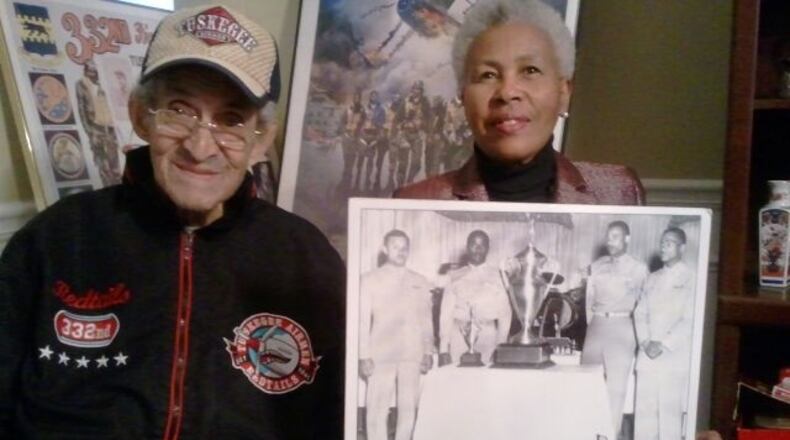For more information go to www.firsttopguns.com or call 404-376-1353.
Zellie Rainey Orr of Atlanta is a hero to surviving members of the famed Tuskegee Airmen, not only for keeping their exploits alive but for finding a long-missing trophy some of the flyers won in a nearly forgotten competition against white comrades just after World War II.
The Tuskegee Airmen were recently depicted in the hit movie “Red Tails,” which focused on the all-black unit’s struggles against racism and its members’ heroics in combat over Europe.
Orr has devoted many years working on behalf of the segregated unit of black men. She does a lot of speaking in schools and to civic and historic groups such as the Atlanta World War II Roundtable, often bringing an Airman along.
“My mom fights hard to keep the memory of what they did alive because they fought for us, and she doesn’t want the world to forget about the ‘little people,’” said daughter Nia Orr, 20.
The 62-year-old widow travels around the country, uncovering relics like the trophy won by a group of Tuskegee Airmen in 1949 in a rigorous competition with white pilots when the military services were still segregated.
Three Tuskegee pilots competed against four white teams in the first ever U.S. Air Force Conventional Class Gunnery Meet that lasted 10 days in Las Vegas. When scores were tallied, the Tuskegee team was declared “top performer.”
A three-foot high “Top Gun” trophy with their names engraved was to be displayed at the Pentagon but went into storage for 55 years. Orr has detailed her painstaking research that led to the discovery of the trophy in a book, “Heroes in War – Heroes at Home: First Top Guns.”
It was “not easy,” she says. “I discovered that the fight against apathy and indifference toward them during the war still prevailed.”
Thanks to her efforts, the trophy is now on permanent display at the National Museum of the United States Air Force in Dayton, Ohio.
The book details the documents and correspondence between Orr and officials that led to the discovery and display of the trophy in an exhibit called “1949 integration of the USAF,” though the military wasn’t desegregated until two months after the competition ended.
WWII Roundtable president Lee Weinstein thanked Orr for telling his group the story of the “mostly unknown accomplishment” of the three Tuskegee pilots.
Retired Air Force Lt. Col. Harry Stewart Jr., 89, of Detroit, one of the men on the winning team, says Orr “is a friend and wonderful person who has done a lot for the Tuskegee Airmen through diligent and unrelenting research.”
Stewart shot down three German planes while chasing away many more that attempted to attack bombers he and his comrades were escorting.
“The trophy is iconic,” he says. “It symbolizes what we did, our contribution.”
Orr says she wrote her book “because people didn’t know about the trophy.”
Among her many accomplishments, she pioneered the re-naming of Camp Creek Parkway “Tuskegee Airmen Parkway.”
There were about 1,000 Tuskegee pilots. According to records, 84 were killed overseas in some 15,000 combat sorties, resulting in 112 aerial kills.
“This is what I will continue to do, speak and educate,” says Orr. “They broke barriers. They fought and died for us all. We cannot forgot.”
About the Author
The Latest
Featured


